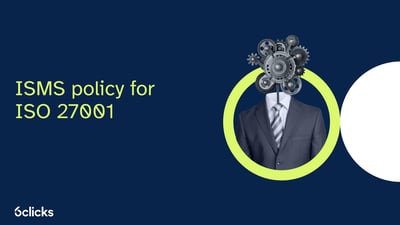Definition of ISMS governance
ISMS governance, also known as Information Security Management System governance, is the practice of establishing and maintaining a framework that ensures the effective management of an organization's information security risks. It involves the development, implementation, and oversight of policies, procedures, and controls that protect an organization's valuable information assets from potential threats, such as cyber attacks. ISMS governance provides a systematic approach to managing information security by aligning it with an organization's business objectives and ensuring compliance with international security standards, such as ISO/IEC 27001. It encompasses activities such as risk assessment, access control, security incident management, and the implementation of preventive and corrective actions. By following a holistic approach to information security management, organizations can effectively mitigate security risks and maintain the confidentiality, integrity, and availability of their information.
Overview of the systematic approach to ISMS governance
ISMS governance involves a systematic approach to managing an organization's information security. It encompasses various key components and processes that ensure the confidentiality, integrity, and availability of information, while also addressing security risks.
At the core of ISMS governance is the establishment of an Information Security Management System (ISMS) governing body. This body provides oversight and ensures alignment with the organization's business strategy. It is responsible for setting objectives, defining policies and procedures, and allocating resources to support the ISMS.
Effective risk management is a critical aspect of ISMS governance. It involves identifying and assessing potential threats to the organization's information assets, and implementing controls to mitigate those risks. This includes regular risk assessments, control implementation, and a continuous monitoring process.
Policies and procedures form the framework of the ISMS governance activities. They provide guidance on security measures, access control, incident response, and other important aspects to ensure the security of the organization's information. Regular review and updates to these policies are crucial to address emerging security threats and to align with changing industry regulations.
Resource allocation is another key consideration in ISMS governance. Adequate resources must be allocated to support the implementation and maintenance of the ISMS. This includes financial resources, skilled personnel, and necessary technologies.
Internal audits play a crucial role in ensuring the effectiveness of the ISMS. Audits assess compliance with policies and procedures, identify potential vulnerabilities, and provide recommendations for improvements. Regular monitoring of metrics and key performance indicators helps track the overall security posture and enables the organization to take corrective actions as needed.
Security risks and management
Security risks and management are essential components of any organization's information security governance. With the increasing prevalence of cyber attacks and the potential threats posed by various security incidents, organizations need to adopt a holistic approach to effectively manage their security risks. This involves implementing a robust security management system (SMS) that includes security controls, policies, and processes, in accordance with international standards such as ISO/IEC 27001. By identifying and assessing potential threats, organizations can develop a comprehensive security strategy and implement the necessary security measures to protect their information assets. Furthermore, security risk assessments and regular monitoring of security performance are crucial to identify vulnerabilities and take preventive actions, ensuring that the organization's security initiatives align with its business objectives. A systematic approach to security risks and management is vital for organizations to safeguard their sensitive data, maintain the trust of their stakeholders, and mitigate potential financial and reputational damages.
Analysis of potential security risks
Analysis of potential security risks is a crucial aspect of ISMS governance. It involves the identification and assessment of potential threats and vulnerabilities that may jeopardize an organization's sensitive information. This process aims to provide a comprehensive understanding of the potential risks and their impacts on the organization's security posture.
To begin, organizations need to identify potential threats that may pose a risk to their sensitive information. These threats can be external, such as cyber attacks, or internal, such as data breaches caused by employees. Once identified, organizations can assess the vulnerabilities that may be exploited by these threats. Common vulnerabilities include weak access controls, outdated software, or lack of security awareness among employees.
The next step is to conduct a thorough risk assessment. This involves evaluating the threat landscape to understand the likelihood of these threats occurring and the potential impact they may have on the organization. Organizations should consider both the frequency and severity of potential security incidents.
By analyzing potential security risks, organizations can prioritize their security efforts and allocate resources effectively. This process enables organizations to develop a proactive approach to risk management by implementing preventive measures and creating a strategy to mitigate potential security incidents.
Identification and implementation of security controls
In the ISMS governance framework, the process of identification and implementation of security controls is crucial to effectively manage and mitigate security risks within an organization. This process involves several steps that ensure comprehensive protection of sensitive information.
To begin, organizations must assess their security risks. This entails identifying potential threats and vulnerabilities that may compromise the security of their information assets. By conducting a thorough risk assessment, organizations can gain insights into the likelihood and potential impact of various security incidents.
Once the security risks have been identified, organizations can select appropriate security controls. These controls are measures or countermeasures that help mitigate the identified risks. Popular information security standards such as ISO/IEC 27001 provide a framework of policies and best practices for selecting and implementing security controls.
The selected controls are then implemented as part of the overall security plan. This involves integrating the controls into the organization's processes, systems, and procedures. The implementation process also includes defining roles and responsibilities for security professionals and ensuring that the controls align with the organization's business objectives.
To ensure the effectiveness of the implemented controls, regular monitoring and evaluation are necessary. This includes conducting audits, reviews, and assessments to assess the ongoing performance of the controls and identify any gaps or areas for improvement.
Development and maintenance of a comprehensive security plan
The development and maintenance of a comprehensive security plan for ISMS governance involves several key steps.
Firstly, organizations need to conduct a thorough risk assessment to identify potential threats and vulnerabilities that may compromise the security of their information assets. This step provides valuable insights into the likelihood and potential impact of various security incidents.
Once the risks have been identified, organizations can select appropriate security controls. These controls are measures or countermeasures that help mitigate the identified risks. By following popular information security standards such as ISO/IEC 27001, organizations can develop a framework of policies and best practices for selecting and implementing these controls.
It is crucial for the security plan to align with the organization's business goals and objectives. By integrating the selected controls into their processes, systems, and procedures, organizations can ensure that information security supports their overall business objectives.
Continuous improvement is also vital in information security. Organizations need to regularly monitor and evaluate the effectiveness of the implemented controls through audits, reviews, and assessments. This ongoing monitoring allows for the identification of any gaps or areas for improvement and ensures that the security plan remains relevant and effective.
ISO/IEC 27001 compliance and certification
Ensuring the security of information assets is a top priority for organizations in today's digital landscape. To effectively manage security risks and meet the requirements of international standards, many organizations choose to implement an Information Security Management System (ISMS) based on ISO/IEC 27001. This globally recognized standard provides a framework for establishing, implementing, maintaining, and continually improving an organization's information security management system. Achieving ISO/IEC 27001 compliance and certification demonstrates an organization's commitment to protecting its information assets and providing a secure environment for stakeholders. In this article, we will explore the essential steps and considerations involved in achieving ISO/IEC 27001 compliance and certification, including risk assessment, security controls, alignment with business objectives, and continuous improvement.
Understanding ISO/IEC 27001 requirements
Understanding ISO/IEC 27001 requirements is essential for organizations seeking compliance with this internationally recognized information security standard. This framework provides a systematic approach to managing and protecting sensitive information, encompassing a range of security controls and risk management processes.
To achieve compliance, organizations must first scope the project, identifying the boundaries of the information security management system (ISMS) and determining the assets and processes to be included. This ensures that resources are focused on critical areas and eliminates unnecessary complexity.
Securing management commitment and resources is crucial for the successful implementation of ISO/IEC 27001. Senior management involvement is necessary to demonstrate leadership and allocate sufficient resources to the ISMS.
Conducting a comprehensive risk assessment is another key requirement. This involves identifying potential threats and vulnerabilities, assessing the likelihood and impact of risks, and determining appropriate risk treatment measures. Based on the risk assessment, organizations can select and implement the necessary security controls to mitigate identified risks.
Developing documentation is another essential step. This includes policies, procedures, and other documentation that define the ISMS and guide its implementation. Staff awareness training is essential to ensure employees understand their responsibilities and how to comply with the requirements of the ISMS.
Finally, organizations must implement corrective and preventive actions to continually improve the effectiveness of the ISMS. This involves identifying and addressing non-conformities, monitoring security performance, and implementing measures to prevent recurrence of issues.
Contractual requirements for compliance
Meeting contractual requirements for compliance is essential for organizations aiming to demonstrate their commitment to data security and gain a competitive edge. Adhering to these requirements not only safeguards valuable information but also opens up new business opportunities by showcasing the organization's dedication to protecting data.
One of the key contractual requirements is obtaining ISO 27001 certification, which validates the implementation and effectiveness of an organization's information security management system (ISMS). By achieving ISO 27001 certification, organizations can showcase their commitment to international standards in information security management, reassuring clients and partners of their ability to protect sensitive data.
In addition to ISO 27001, organizations may need to consider other industry regulations and standards depending on their specific business sector. For example, organizations in the healthcare industry may need to comply with the Health Insurance Portability and Accountability Act (HIPAA), while those in the financial sector may need to adhere to regulations such as the Payment Card Industry Data Security Standard (PCI DSS).
Obtaining certification from a recognized certification body
Obtaining certification from a recognized certification body is a crucial step in achieving ISO/IEC 27001 compliance. This process involves a formal audit conducted by the certification body to evaluate the organization's information security management system (ISMS) against the ISO/IEC 27001 standard.
The certification process typically consists of two steps. First, the organization submits documentation and evidence demonstrating their compliance with the standard's requirements. This documentation includes policies, procedures, and records of security controls implemented to protect information assets. The certification body reviews the documentation to ensure it aligns with the ISO/IEC 27001 requirements.
The second step involves an on-site audit conducted by the certification body's auditors. The auditors evaluate the organization's ISMS implementation, assess the effectiveness of security controls, and verify compliance with ISO/IEC 27001 requirements. The audit may include interviews with employees, observations of security practices, and a review of security-related documentation.
Achieving ISO/IEC 27001 certification is an internationally recognized achievement. It demonstrates the organization's commitment to information security and can provide significant benefits in establishing relationships with external stakeholders. Proof of certification can enhance the organization's credibility, increase customer confidence, and differentiate it from competitors in the market.
By undergoing the formal audit process and obtaining ISO/IEC 27001 certification from a recognized certification body, organizations can showcase their dedication to information security and gain a competitive edge in today's digital landscape.
International standards for security practices
International standards for security practices provide organizations with a framework to effectively manage and mitigate security risks. These standards, such as ISO/IEC 27001, offer guidelines and best practices for implementing security controls, risk assessment, and governance activities. By adhering to these standards, organizations can ensure the confidentiality, integrity, and availability of their information assets. Achieving certification to these international standards demonstrates an organization's commitment to information security and can enhance its reputation, credibility, and trustworthiness among stakeholders. In this article, we will explore the importance of international security standards and the benefits they offer in establishing robust security practices.
Familiarity with common international standards for security practices
Familiarity with common international standards for security practices is crucial for effective ISMS (Information Security Management Systems) governance. These standards provide a framework of policies and practices that organizations can follow to ensure the security and protection of their valuable information assets.
One such widely recognized standard is ISO/IEC 27001, which defines the requirements for establishing, implementing, maintaining, and continually improving an ISMS. It outlines security controls, risk assessment methodologies, and preventive actions to safeguard against potential threats and cyber attacks.
By familiarizing themselves with international security standards like ISO/IEC 27001, organizations can ensure a systematic approach to security governance activities. They can align their security policies, processes, and measures with these standards, which helps in identifying and mitigating security risks.
Understanding these standards is essential as they provide a holistic approach to security management, helping organizations set security objectives that align with their business objectives. Adhering to these standards not only helps in improving the level of security but also instills confidence in customers and stakeholders.
To implement these standards, organizations should consider working with a certification body that can guide them through the certification process. This involves asset management, risk assessment, security controls implementation, and regular security performance evaluations.
Applying relevant ISO/IEC standards to business objectives
Applying relevant ISO/IEC standards to business objectives, such as ISO/IEC 27001, is crucial for implementing an effective information security framework. ISO/IEC 27001 is an internationally recognized standard that defines the requirements for establishing, implementing, maintaining, and continually improving an Information Security Management System (ISMS).
By adopting ISO/IEC 27001, organizations can reduce vulnerabilities to cyber attacks and respond effectively to evolving security risks. This standard outlines security controls, risk assessment methodologies, and preventive actions that help safeguard against potential threats. It enables organizations to identify and address vulnerabilities in their systems, ensuring the security of their assets.
Implementing ISO/IEC 27001 also allows organizations to centrally manage their information security practices. They can align their security policies, processes, and measures with the standard, ensuring a systematic approach to security governance. This helps in centrally managing and coordinating security initiatives, as well as enabling effective tracking and monitoring of security incidents and performance.
By adhering to ISO/IEC 27001, organizations not only enhance their level of security but also demonstrate their commitment to protecting sensitive information. This instills confidence in customers and stakeholders and can open doors to new business opportunities. Overall, applying relevant ISO/IEC standards to business objectives provides a solid foundation for information security and supports the long-term success of the organization.
Ensuring compliance with international standards for security measures
Ensuring compliance with international standards for security measures is crucial for organizations to establish robust and effective security governance. Aligning security measures with recognized frameworks and standards such as ISO/IEC 27001 is an essential step towards achieving this goal.
ISO/IEC 27001 is an internationally recognized standard that provides a comprehensive framework for managing information security risks. By adopting this standard, organizations can ensure that their security measures adhere to globally accepted practices and meet the requirements set forth by regulatory bodies and certification bodies.
Implementing ISO/IEC 27001 requires organizations to identify and implement relevant controls and practices that are tailored to their specific security requirements. This includes conducting risk assessments, establishing a security policy, implementing access controls, managing assets, and implementing incident response procedures, among other measures.
By following the ISO/IEC 27001 framework, organizations can effectively manage and mitigate security risks, protect their assets, and demonstrate their commitment to information security to stakeholders. This not only helps in safeguarding against potential security breaches but also enhances the organization's reputation and instills confidence in customers, partners, and clients.
In today's increasingly interconnected and digitized world, compliance with international standards for security measures is essential. Organizations must prioritize aligning their security practices with recognized frameworks and standards to ensure the security and integrity of their systems and data. By implementing ISO/IEC 27001, organizations can meet these requirements and establish a robust and effective security governance framework.
Holistic approach to ISMS governance
A holistic approach to ISMS governance encompasses the comprehensive management and oversight of an organization's information security practices. It involves taking a strategic and integrated approach to ensure that all aspects of information security are aligned with the organization's overall objectives and goals.
Key components of a holistic approach to ISMS governance include:
1. Aligning information security objectives with business strategy: It is crucial to ensure that the organization's information security objectives are aligned with its overall business strategy. This ensures that information security measures support and contribute to the achievement of the organization's goals.
2. Implementing a risk management program: A holistic approach to ISMS governance involves implementing a robust risk management program. This program assesses and manages the risks that the organization faces in relation to information security. It includes activities such as identifying and analyzing risks, implementing controls to mitigate risks, and regularly reviewing and updating risk assessments.
3. Establishing policies and procedures: An effective holistic approach to ISMS governance includes the establishment of clear and comprehensive policies and procedures for information security. These policies and procedures provide guidance on how to protect information assets, handle security incidents, and comply with relevant laws and regulations.
4. Allocating resources: Adequate resources, including budget, personnel, and technology, need to be allocated to support the implementation and maintenance of the ISMS. This includes ensuring that there is sufficient funding and skilled personnel available to implement controls, conduct audits, and respond to incidents.
5. Conducting internal audits: Regular internal audits are essential for monitoring the effectiveness of the ISMS and identifying areas for improvement. Internal audits help ensure that the organization's information security practices are in line with established policies and industry best practices.
6. Measuring performance: A holistic approach to ISMS governance involves the establishment of performance metrics and indicators to measure the effectiveness of information security practices. This enables the organization to track progress, identify trends, and make informed decisions to continuously enhance the ISMS.
By adopting a holistic approach to ISMS governance, organizations can effectively manage information security risks, protect their assets, and demonstrate a commitment to information security. This not only helps safeguard against potential security breaches but also enhances the organization's reputation and instills confidence in stakeholders.
Written by Andrew Robinson
Andrew started his career in the startup world and went on to perform in cyber and information security advisory roles for the Australian Federal Government and several Victorian Government entities. Andrew has a Masters in Policing, Intelligence and Counter-Terrorism (PICT) specialising in Cyber Security and holds IRAP, ISO 27001 LA, CISSP, CISM and SCF certifications.












